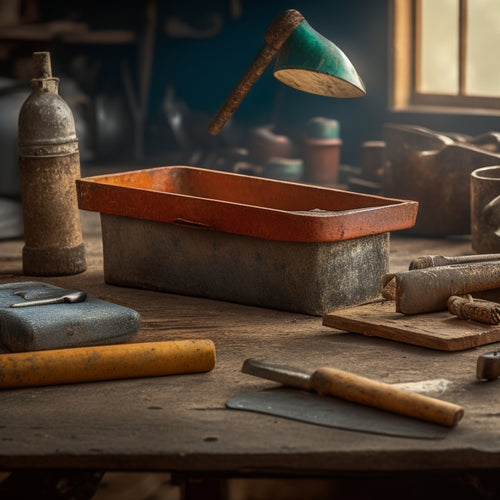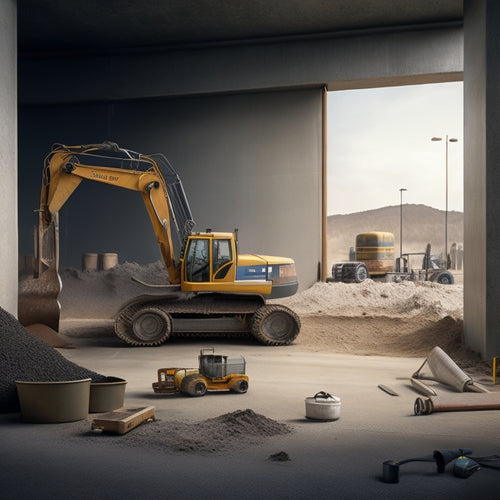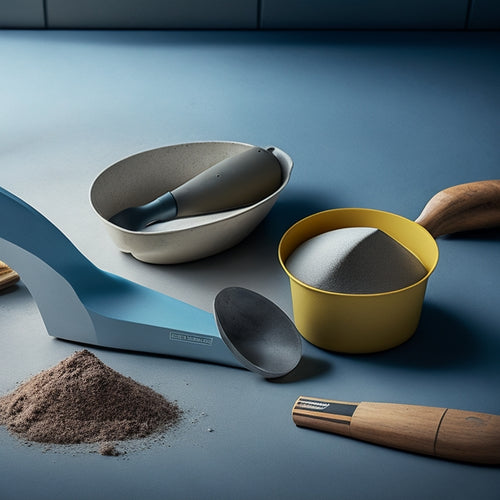Why Start With These Concrete Tools for Beginners
Share
As a beginner, starting with the right concrete tools is essential for achieving a successful project. You'll need important tools like a heavy-duty wheelbarrow, mixing bucket, and trowel to get started. Must-have tamping tools, leveling tools, and edging tools will help you achieve a smooth, even surface. Investing in these fundamental tools will prevent common mistakes and guarantee your project turns out strong and durable. By mastering these tools, you'll set yourself up for success and be ready to take on more complex projects - and with the right guidance, you'll be able to access even more advanced techniques to perfect your craft.
Key Takeaways
• Mastering essential tools and techniques is vital for project success and prevents common mistakes made by beginners.
• Having the right tools ensures a strong and durable concrete finish, saving time and resources in the long run.
• Starting with the basics helps build confidence and develops skills, making it easier to tackle complex projects later on.
• Familiarity with concrete tools and techniques enables beginners to identify and correct errors early, reducing the risk of costly rework.
• Investing in quality tools and learning proper techniques leads to professional-looking results, enhancing the overall reputation and credibility of beginners.
Essential Tools for Beginners
Start by investing in a set of essential tools that will help you achieve professional-looking results, including a heavy-duty wheelbarrow, a mixing bucket, a trowel, a level, and a variety of finishing tools. These tools will be your foundation for successful concrete pouring projects.
As you begin, prioritize tool safety by ensuring each tool is in good condition and you're familiar with its proper use. A wheelbarrow will help you transport heavy loads of concrete, while a mixing bucket will make it easier to prepare the perfect mix.
A trowel will be your go-to for smoothing out the concrete, and a level will guarantee a perfectly even surface. Finishing tools, such as edgers and floats, will give your project a polished finish.
Must-Have Tamping Tools
Must-Have Tamping Tools
With your essential tools in place, you'll need to add must-have tamping tools to your arsenal, as they play a vital role in removing air pockets and guaranteeing a solid, compacted concrete surface. Tamping tools help you achieve a smooth, even finish by eliminating voids and air pockets that can lead to cracks and weaknesses.
| Tool | Description |
|---|---|
| Hand Tamper | A manual tool used for small areas and tight spaces |
| Plate Compactor | A heavy-duty tool for large areas and high-traffic zones |
| Tamper Bar | A versatile tool for both small and large areas |
When selecting tamping tools, consider the size of your project and the type of concrete you're working with. Mastering tamping techniques is essential to achieving a professional finish. Additionally, tool maintenance is important to extend the life of your tamping tools and guarantee they continue to perform at their best. Regularly clean and inspect your tools to prevent damage and wear. By incorporating these must-have tamping tools into your workflow, you'll be well on your way to producing high-quality concrete finishes.
Edging Tools for Clean Finish
To achieve a clean, defined edge on your concrete surface, you'll need to invest in the right edging tools that can help you create a seamless shift between the concrete and adjacent materials. Edging tools are designed to shape, smooth, and finish the concrete edge, ensuring a professional-looking result.
When choosing edging tools, consider the material choices you've made for your project. For instance, if you're working with a decorative concrete overlay, you'll need edging tools that can handle the intricate designs and patterns. In this case, an edger with interchangeable blades would be an excellent choice.
Mastering edging techniques requires practice, patience, and the right tools. Start by selecting the correct edger for your project, then practice your technique on a small, inconspicuous area. As you gain confidence, move on to more complex edging tasks.
Leveling Tools for Perfection
When you're working with concrete, achieving a perfectly level surface is vital.
To get it right, you'll need to align your tools with precision, check for errors along the way, and maintain straight lines throughout the process.
Align With Precision
With precision leveling, you guarantee that your concrete structures stand the test of time, and a well-stocked arsenal of leveling tools is vital to achieving this goal.
As a beginner, it's important to master alignment techniques that ensure your concrete projects are accurate and reliable. Start by investing in a high-quality spirit level, which provides precision measurements to within 0.05 degrees. This tool is perfect for checking the levelness of surfaces, detecting even the slightest deviations.
Next, incorporate a laser level into your toolkit. This device projects a precise level line or dot, allowing you to achieve accurate alignment over longer distances. When working with complex concrete structures, a rotary laser level is ideal, as it provides 360-degree coverage and increased accuracy.
Check for Errors
You'll need to regularly check for errors and deviations during the concrete construction process, as even slight miscalculations can lead to costly mistakes and compromised structural integrity.
To guarantee accuracy, you must develop a keen eye for detail and a systematic approach to error identification.
As you work, continually monitor your progress, and don't hesitate to stop and correct mistakes as soon as you spot them. This proactive approach will save you time, money, and frustration in the long run.
Some essential techniques to master include:
-
Double-checking calculations and measurements to prevent errors
-
Conducting regular visual inspections to catch deviations early
-
Implementing correction techniques, such as re-leveling or re-plumbing, to get back on track
Maintain Straight Lines
Achieving precision in concrete construction requires mastering the art of maintaining straight lines, which hinges on selecting and utilizing the right leveling tools for the job. You'll want to guarantee that your concrete textures are even and consistent, and that's where leveling tools come in. When choosing a leveling tool, consider the type of project you're working on, the size of the area, and the level of precision required.
Here's a breakdown of popular leveling tools and their uses:
| Tool | Purpose | Accuracy |
|---|---|---|
| Spirit Level | General leveling, checking surfaces | ±0.5 mm/m |
| Laser Level | Large areas, precision leveling | ±0.1 mm/m |
| Torpedo Level | Tight spaces, precision leveling | ±0.1 mm/m |
| Digital Level | High-precision leveling, data tracking | ±0.01 mm/m |
| Optical Level | High-precision leveling, long distances | ±0.01 mm/m |
Basic Finishing Tool Kit
Your basic finishing tool kit should include a set of essential tools that help you achieve a smooth, even finish on your concrete project.
As a beginner, it's easy to fall into the trap of thinking that more tools are better, but this can lead to tool organization chaos and common beginner mistakes. Instead, focus on the must-haves that will get the job done efficiently.
Here are the top three essentials to include in your basic finishing tool kit:
-
A high-quality trowel for applying and leveling concrete
-
An edger for creating clean, defined edges and joints
-
A float for smoothing out the surface and removing excess material
Protecting Surfaces With Mats
Before pouring concrete, lay down protective mats to prevent damage to surrounding surfaces, ensuring a clean and efficient work environment. You'll be surprised at how easily concrete can stain or damage surfaces, so it's vital to take this step seriously. High-quality mats designed for surface protection are a worthwhile investment, offering durability and reliability. Look for mats made from heavy-duty materials that can withstand the weight of concrete and foot traffic.
When choosing mats, consider the size and shape of your work area, as well as the type of surface you're working on. Mats with textured surfaces can provide additional grip, reducing the risk of slips and falls.
Concrete Mixing Essentials
What's the right ratio of cement to water, and how do you guarantee a consistent mix to achieve the perfect concrete?
As a beginner, it's crucial to master the art of concrete mixing to assure a strong and durable finish. The ideal ratio of cement to water is typically around 1:3 to 1:5, but this can vary depending on the type of cement and the specific project requirements.
When it comes to mixing techniques, you'll want to:
-
Start by adding half of the water to the mixer, then gradually add the cement while mixing
-
Use a slow and steady mixing motion to avoid creating air pockets
-
Stop the mixer occasionally to scrape down the sides and verify all ingredients are well incorporated
Remember to take necessary safety precautions when mixing concrete, including wearing protective gloves, safety glasses, and a dust mask.
Also, make sure the mixing area is well-ventilated and free from any tripping hazards.
Finishing Hand Tools Required
You'll need a set of essential finishing hand tools to achieve a smooth, even finish and bring your concrete project to life. These tools will help you master various concrete finishing techniques, ensuring your beginner's project ideas turn out as envisioned.
Start with a trowel, which will allow you to spread and smooth out the concrete. A finishing float is another must-have, as it helps to remove excess water and even out the surface. An edger is also vital, as it creates a clean, defined edge along walls and other boundaries.
Don't forget a jointing tool, which will help you create control joints and prevent cracking. Finally, a finishing brush will give your project a smooth, even texture.
With these finishing hand tools, you'll be able to achieve a professional-looking finish on your concrete project. Whether you're creating a decorative planter or a functional patio, these tools will help you get the job done right.
Smoothing Tools for Beginners
To achieve a high-gloss finish or a subtle texture, utilize smoothing tools specifically designed to eliminate imperfections and refine the surface of your concrete project. These tools are essential for surface preparation, allowing you to accomplish a smooth, even finish that enhances the overall appearance of your project.
When it comes to smoothing techniques, you'll want to have the right tools for the job. Here are a few essentials to get you started:
-
Trowels: Ideal for applying and smoothing out concrete, trowels come in various sizes and angles to suit your specific needs.
-
Floats: Used to remove excess water and smooth out the surface, floats are a must-have for achieving a high-gloss finish.
-
Steel tamping tools: These tools help to remove air pockets and guarantee a smooth, even surface.
Common Tool Accessories Needed
Beyond smoothing tools, you'll need a range of accessories to complement your toolkit and guarantee a successful concrete project. These accessories may seem secondary, but they're essential for efficient and safe work.
To begin with, prioritize tool safety with accessories like safety glasses, gloves, and a dust mask. These will protect you from debris, dust, and other hazards common in concrete work.
Next, consider accessory storage solutions like toolboxes, buckets, or bags to keep your equipment organized and within reach. This will save you time and reduce fatigue.
You may also need accessories like tamping rods, edgers, and jointers to achieve specific finishes or textures.
Additionally, don't forget about cleaning accessories like wire brushes and scrubbers to maintain your tools and equipment.
Frequently Asked Questions
What Safety Gear Is Necessary When Working With Concrete Tools?
When working with concrete tools, you'll need essential safety gear to prevent injuries.
First, invest in protective equipment like gloves, safety glasses, and a dust mask to shield yourself from debris and dust.
A hard hat and steel-toed boots are also must-haves to protect your head and feet from falling objects and heavy tools.
Don't forget to wear long sleeves, pants, and a respirator to prevent skin and lung irritation.
Always prioritize safety to guarantee a successful project.
Can I Use Concrete Tools for Other Masonry Projects Too?
You're wondering if your concrete tools can handle other masonry projects. The answer is yes!
These tools are incredibly versatile, and their applications go far beyond concrete. You can use them for bricklaying, blockwork, stonework, and even tile setting.
Their durability and precision make them perfect for a wide range of masonry project applications.
How Often Should I Clean and Maintain My Concrete Tools?
You're like a surgeon with their scalpel - you need your concrete tools to be in pristine condition to precision-craft your masonry masterpieces.
For peak performance, clean your tools after every use, and perform a deep clean every 1-2 weeks.
Regular maintenance tips include lubricating moving parts, storing tools in a dry place, and sharpening blades regularly.
Are There Any Specific Storage Requirements for Concrete Tools?
When it comes to storing your concrete tools, you'll want to prioritize storage conditions that prevent rust, corrosion, and damage.
Organize your tools in a dry, well-ventilated area, away from direct sunlight and moisture.
Implement a tool organization system, such as a toolbox or pegboard, to keep tools within easy reach and prevent clutter.
Can I Rent Concrete Tools Instead of Buying Them Outright?
You're considering renting concrete tools instead of buying them outright, and that's a smart move.
Rental options can offer significant cost benefits, especially if you only need the tools for a one-time project.
By renting, you'll avoid the upfront capital expenditure and storage concerns.
Plus, rental companies often provide well-maintained equipment, ensuring you get the job done efficiently.
Weigh the rental costs against your project's needs to determine if renting is the way to go.
Conclusion
You've got the foundation laid, literally!
With these concrete tools for beginners, you're ready to build a solid career in the trade.
Think of them as the keys to accessing a treasure trove of possibilities - without them, you're stuck in the mud.
Now, get out there and start building; the world is your canvas, and these tools are your brushes.
Related Posts
-

Smart Guide to Buying Used Concrete Hand Tools
You're about to buy used concrete hand tools, and you need to get it right. Dedicate time to identify the tools you n...
-

Why You Need Affordable Concrete Wall Construction Tools
You need affordable concrete wall construction tools to guarantee a profitable project, as the cost of equipment can ...
-

Ergonomic Concrete Tools for Tight Spaces
When you're tackling concrete work in tight spaces, ergonomic tools are your best bet for comfort and efficiency. The...


